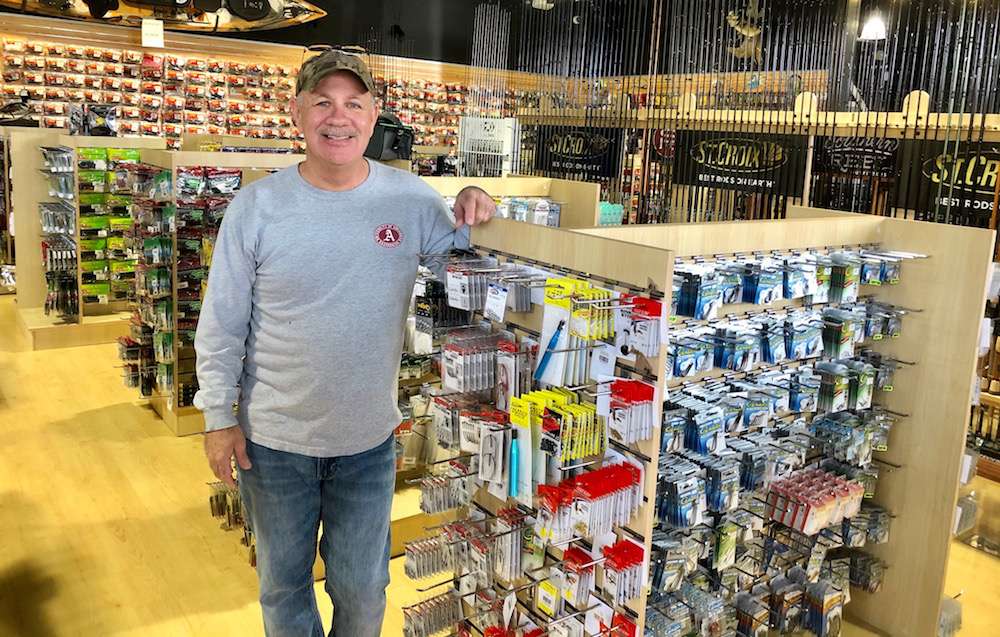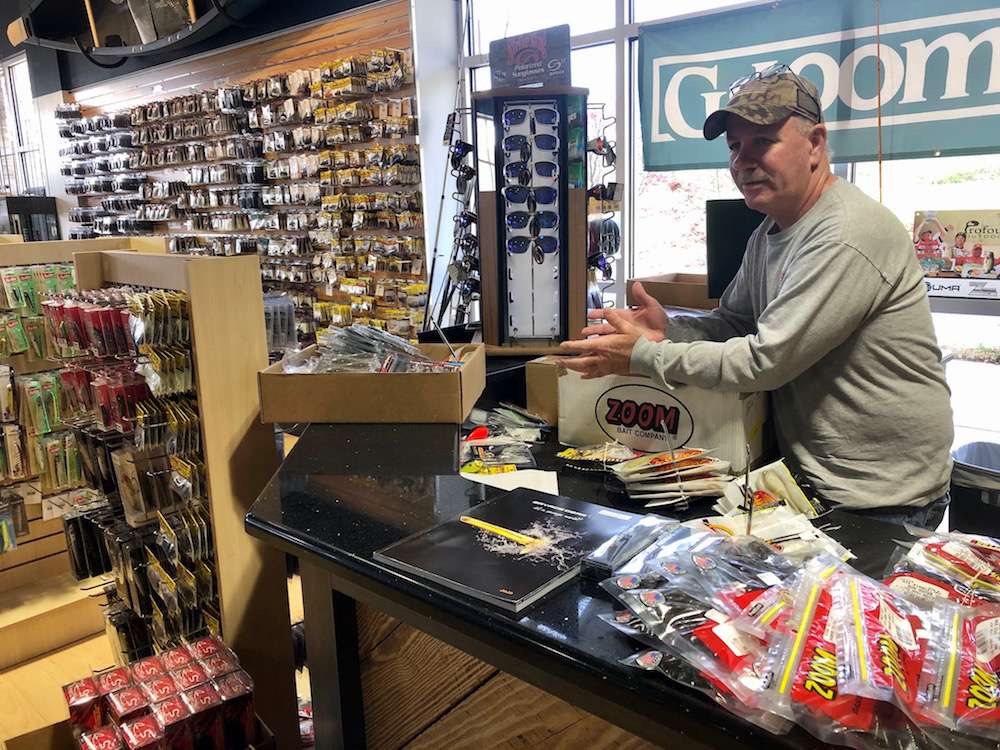
LITTLE ROCK, Ark. — Scott Rook hasn’t fished a Bassmaster Elite Series tournament since October 2018. In fact, he hasn’t fished a tournament of any kind since then.
But Rook is still reeling ‘em in. Since his retirement from professional fishing, the 59-year-old Little Rock native has shifted his focus from B.A.S.S. to those angling for b-a-s-s – and every other fish species. Rook is the manager of Southern Reel Outfitters, a 5,000-square-foot retail store containing everything on any angler’s wish list.
Fortunately for Rook and store-owner Rodney Thomason, the state of Arkansas’ official restrictions in dealing with the coronavirus pandemic have allowed the business to remain open. And it’s thriving.
“Like every small business, we were scared to death,” Rook said. “But when they started furloughing and laying people off and closed the schools, business picked up. We had a ton of new customers, people who said, ‘I haven’t fished in five years.’ I heard that a lot. They bought a lot of terminal tackle – bobbers and sinkers and hooks for live bait fishing.
“But then the rod and reel sales picked up, and we’re actually ahead for the month of April from where we were last year. And we had a banner month of April last year.”
Rook is well aware of the responsibilities of operating a retail store during the COVID-19 pandemic.
“We have tried to keep everything clean,” he said. “We’re wiping the (cash register) counter down after every customer. We’re wiping the front door like three times an hour. We rarely have 10 customers in here at a time. Usually it’s – at most – four, five or six at a time. They come and go all day long. People are wearing masks now too. That’s good.
“If you can pull any positive out of this whole coronavirus deal, it’s the timing of it. It did hit in April when the fishing is at its best. There are people fishing on the banks everywhere.”
Rook is thriving too. Retirement from the Elite Series hasn’t meant sitting around the house.
“It’s a good retirement job for me,” Rook said. “It’s close to the house. It takes me three minutes to get here from my house. A good buddy of mine, Rodney Thomason, owns the store. We used to fish tournaments together back in the day. I can’t just sit at home and twiddle my thumbs. You can only hunt and fish so much.”
Despite working 40 hours a week, Rook finds plenty of time to fish and hunt. Scott and his wife, Kathy, have no children, but Scott has long been sharing his fishing and hunting skills with their nephews, John Robert and Charlie Baxter, now 12 and 10, respectively.
The combination of teaching his nephews and Rook’s long tournament career gives him a unique ability to communicate with anglers of all ages and experience. Rook’s career highlights include a $250,000 first place check in the Elite Series Legends event on the Arkansas River in 2006, a second-place finish – by 17 ounces – to Kevin VanDam in the 2001 Bassmaster Classic at the Louisiana Delta and $1.5 million in B.A.S.S. tournament winnings.
“Sometimes people are intimidated by a pro fisherman,” Rook said. “They shouldn’t be. I’m just another guy, another fisherman. And I’m finally getting a lot of these customers comfortable with asking me questions. Being able to share all that information is fun. I love that. I really do.”
But the number one question he’s asked is this: Do you miss fishing the Elite Series?
“The traveling is what burned me out,” Rook said. “I still love to fish, and I still go a lot. I don’t fish any tournaments. But I had a great time. Twenty-two years I fished with B.A.S.S. That’s a long time. And I fished tournaments around here for 15 years before that. I was just burned out on traveling, and I wanted to be home more.
“To be a professional fisherman, there are a lot of sacrifices. One of them is being gone, missing birthdays, missing holidays. It’s nice being home. I miss my buddies. I miss some of the awesome fishing, like at the St. Lawrence River and Falcon Lake, those kinds of places. I miss that a lot.”
Speaking of those two places, Rook caught his best five-smallmouth bass limit on the St. Lawrence River in his last regular season Elite Series event: 25 pounds, 11 ounces, on Aug. 23, 2018, when he finished 17th. His best five-largemouth limit came at Falcon Lake: 35 pounds, 12 ounces, on April 3, 2008, when he finished sixth in the four-day event with a total of 128 pounds, 15 ounces.
It seems that every angler wants to share his fishing stories with a pro. And every pro will tell you how tiresome that can be. Rook used to hear them while working boat shows, “Until your ears bled.” Anglers still love telling Rook their fish stories. He hears plenty. Southern Reel Outfitters is located about 10 miles from both Lake Maumelle and the Murray Park ramp on the Arkansas River. It’s approximately a 90-minute drive to both Lake Ouachita and Greers Ferry Lake. And now Rook loves hearing those fish stories.
“When somebody comes in here, they’ll ask, ‘What are they biting on?’” he said. “I’ll say, ‘Where are you going?’ I hear enough in here that I can just about give them an answer for anything. I don’t have to go to Lake Ouachita to know what they’re biting on. I see what customers are buying, and they’re going to tell me their fish stories. It becomes an advantage in here.”
So, yeah, Scott Rook is enjoying “retirement” just fine.

Rook’s top three tips
Scott Rook enjoys sharing his fishing knowledge with customers at Southern Reel Outfitters. It often goes something like this:
“Right after I started here, this guy comes in and said he wants to pick my brain about something,” Rook recalled. “He said he was missing about 75 to 80 percent of the bites he was getting on a shaky head. I said are you setting the hook? He said, oh, yeah, I’m setting it real hard. I told him that was his first mistake. You want to just pull back into them.”
Then Rook and the customer delved into the rod, reel and line setup. That’s advice Rook finds himself giving most frequently, and it centers on braided line with a fluorocarbon leader, particularly on spinning reels.
“He came back about two weeks later and said he hadn’t lost a fish on a shaky head,” Rook said.
When asked to name his most frequent advice to customers, that story illustrates two of them: 1) braided line and a fluorocarbon leader, and 2) how to tie the Albright knot to join braid to leader.
“I can’t tell you how many people I’ve taught to tie that knot,” Rook said. “That setup is a game changer. You can put braid on once a year. You can actually pull it off, turn it around and tie it back on because you’ve got unused line at the bottom of the spool, and braid doesn’t have any memory.”
Rook uses 10-pound test braid and 8-pound test fluorocarbon leader in just about every situation.
“I was catching 5- and 6-pound smallmouth at the St. Lawrence River,” said Rook, mentioning his last Elite Series tournament in 2018. “I put on a 6-pound test leader, but I didn’t see any difference in the number of bites I got. So I use 8-pound test on everything.”
Number three on the list of most frequently asked questions concerns topwater baits. It’s always about what colors to use in a topwater lure that might come in 20 different color patterns. From there, Rook takes customers to a tactic they might not have considered – retrieve speed.
“Color is pretty elementary for me,” Rook said. “It’s black and white, dark and light. You look at the color of the sky. I let the sky decide. The fish is attracted to the sound and vibration of that bait. He’s not attracted to the color. But when he gets there, he’s got to have a visible target to zero-in on. If it’s an overcast, gray day, and it’s a white lure, he can’t see it. He blows up on it and misses. But if you put a black or dark-colored lure on, it contrasts with the sky.
“On a sunny day, with a clear sky, I’ll start with a white or shad color. If they’re blowing up on it and missing it, I’ll go to a darker color.”
The key is to keep experimenting. If bass are striking a topwater lure, half the puzzle is solved. You know they want it. Now you’ve got to find out exactly how they want it presented. First, change colors – from light to dark or vice versa. Then change retrieve speeds – speed up or slow down.
“If they blow up on it, they’re trying to eat it,” Rook said. “There’s something you’re doing – either the color or the retrieve speed that’s keeping them from getting it.”




